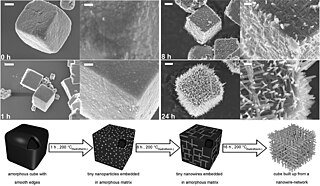Self-organizing systems
process of creating order by local interactions
(Redirected from Self-organizing)
Self-organizing systems are structures that process where some form of overall order or coordination arises out of the local interactions between smaller component parts of an initially disordered system. The process of self-organization can be spontaneous, and it is not necessarily controlled by any auxiliary agent outside of the system. It is often triggered by random fluctuations that are amplified by positive feedback. The resulting organization is wholly decentralized or distributed over all the components of the system.

Quotes
edit- Such a system is “self-organizing” in the sense that it changes from “parts separated” to “parts joined.”
- W. Ross Ashby, “Principles of the self-organizing system,” in Principles of Self-Organization: Transactions of the University of Illinois Symposium, H. Von Foerster and G. W. Zopf, Jr. (eds.), Pergamon Press: London, UK (1962) pp. 255-278.
- Every isolated determinate dynamic system, obeying unchanging laws, will ultimately develop some sort of organisms that are adapted to their environments.
- W. Ross Ashby, “Principles of the self-organizing system,” in Principles of Self-Organization: Transactions of the University of Illinois Symposium, H. Von Foerster and G. W. Zopf, Jr. (eds.), Pergamon Press: London, UK (1962) pp. 255-278.
- This is a general characteristic of self-organizing systems: they are robust or resilient. This means that they are relatively insensitive to perturbations or errors, and have a strong capacity to restore themselves, unlike most human designed systems.
- Francis Heylighen, “The Science of Self-Organization and Adaptivity”, Center "Leo Apostel", Free University of Brussels, Belgium (2001) p. 9. Also, The Encyclopedia of Life Support Systems 5 (3), 253-280.
- In that sense, a self-organizing system is intrinsically adaptive: it maintains its basic organization in spite of continuing changes in its environment. As noted, perturbations may even make the system more robust, by helping it to discover a more stable organization.
- Francis Heylighen, “Complexity and Self-Organization” (2008), Center "Leo Apostel", Free University of Brussels, Belgium, p. 10. Also, Encyclopedia of Library and Information Sciences (2008) pp. 1215-1224.
- Nature is pretty good at networks, self-organizing systems. By contrast, social systems are top-down and hierarchical, from which we draw the basic assumption that organization and order can only come from centralism.
- As quoted by Nicholas Negroponte in “Online Extra: Q&A With MIT's Nicholas Negroponte,” Bloomberg Business, (June 20, 2004)
- We have seen that the formation and maintenance of self-organizing systems are compatible with the laws of physical chemistry.”
- Ilya Prigogine, G. Nicolis & A. Babloyantz, “Thermodynamics of evolution,” Physics Today 25(12), 38-44 (1972)
- A self–organizing system acts autonomously, as if the interconnecting components had a single mind. And as these components spontaneously march to the beat of their own drummer, they organize, adapt, and evolve toward a greater complexity than one would ever expect by just looking at the parts by themselves.
- L.K. Samuels, In Defense of Chaos: The Chaology of Politics, Economics and Human Action, Cobden Press (2013) p. 225.
- Falling between order and chaos, the moment of complexity is the point at which self-organizing systems emerge to create new patterns of coherence and structures of behaviour.
- M.C. Taylor, The Moment of Complexity: Emerging Network Culture (2001) p. 25.